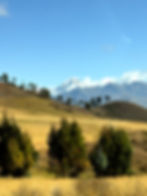The Sacred Valley of Peru
- ellen
- Jul 3
- 3 min read

The Sacred Valley of Peru is an area stretching about 60 miles from the town of Pisac, 20 miles northeast of Cusco, to Machu Picchu. It runs along the beautiful Urubamba River and derives its name at least in part from the Incan temples that dotted it as well as its natural beauty and fertility.

We spent an unforgettable day with our guide driving through it on our way to Ollantaytambo where we boarded the train to Machu Picchu. Cusco, where we stayed the preceding two days, is a large, sprawling city. It took close to 30 minutes to reach the outskirts on our way to the Sacred Valley.
Heading out of Cusco in the morning...

The urban sprawl soon became a lovely landscape.

Salt Mines of Maras
Our first stop was the salt mines of Maras, otherwise known as basins or ponds.


These ponds have been mined since pre-Incan times. There are about 5,000 of them, owned by 700 local families. Each family owns from a few to dozens and they are passed down from generation to generation. Ponds may not be sold to anyone outside the family. When a family member marries, a pond is established for the couple.

The ponds are filled with water via tiny rivulets from the surrounding mountains. Each pond is only a few inches deep. Once filled, the water evaporates over a period of a few days and the pond is ready to be mined. Each pond is mined about three times a month and produces close to 500 lbs. of salt per month.

Three kinds of salt are produced; pink salt which is the highest quality, destined for gourmet use; white salt, also for cooking, but not as high quality as pink; and brown which is used mainly for industrial and agricultural purposes.
The stone on top indicates that the pond is ready to be mined.

Drying it out...

This man is preparing a pond. It looked like back-breaking work!
Salt in the making...


Seeing and learning about these ponds was a highlight of the trip!
The Terraces at Moray

While the precise use of these 500 year-old terraces is still a matter of debate, it's widely believed that they were used as an experimental farm by the Incans. A series of channels from the surrounding mountains was used for irrigation and archeologists found that the temperature difference from top to bottom is a whopping 27 degrees!

The elevation difference between each terrace was enough to create separate microclimates and therefore grow different types of crops. They also found that the sun hit each terrace at different angles contributing to the temperature difference. It is believed that corn and potatoes were among the crops grown there.
Today the site is protected and used largely for tourism.
Ollantaytambo
The end of the line for us was Ollantaytambo, a bustling village of about 10,000 residents. It has been inhabited since the late 15th century and contains some of the oldest continually occupied dwellings in South America. The busy train station is in the center of town.

Some more photos of our day in the Sacred Valley.
See also our posts on Lima, Cusco and Machu Picchu.
➜ Top Tip
There is more to see in the Sacred Valley than what we saw on our drive. Depending on how much time you have, staying overnight would be a good option. There are a number of beautiful hotels to choose from.


























